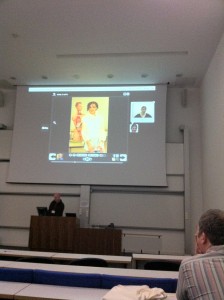 Firstly let me start with offering my thanks to Durham University Learning Technologies Team for organising the event and being great hosts. Also apologies that I have a limited amount of photographs as I did not play the role of the paparazzi this year. The ones I do have, mainly of the food as I was very impressed by the catering, have already been used by Chris.
Firstly let me start with offering my thanks to Durham University Learning Technologies Team for organising the event and being great hosts. Also apologies that I have a limited amount of photographs as I did not play the role of the paparazzi this year. The ones I do have, mainly of the food as I was very impressed by the catering, have already been used by Chris.
This year the theme was Location, Location, Location and they definitely have the right location to host this conference; a picturesque and beautiful city; all the presentations and delicious lunch held in one building which is very beneficial and finally having the dinner in Durham Castle, what an experience. This all makes it a unique conference to attend and participate in.
There was once a discussion of whether this conferences location should be changed each year,I’m sure Durham’s Learning Technologies Team would welcome this, due to all the organising that has to take place, but they have mastered the art and have the perfect setting for such an event.
Onto the presentations.
3 Steps to Success – Nichola Hayes, Leicester University
As I have been working in the field of distance learning I wanted to attend this session to see what other institutions have been doing in the field.
The presentation did not go into distance learning materials but focused more on how to ensure the distance learner did not feel they were out there alone and were also up to speed on Blackboard and what support and resources were available before their course started.
They didnt want students to have to learn how to use Blackboard as well as learning their degree topic so they introduced the 3 Steps to Success. This involved what they reference as a Blackboard Taster Module, Orientation Module and Module One.
Blackboard Taster Module is available to the students after the first enquiry is made to the institution. It mentions sections and tools of Blackboard that will be used in the module using screenshots.
Orientation Module was made available 2 weeks before the course start date. Is more hands on and includes some general support materials, such as the student handbook, but nothing course specific. The students will now be able to familiarise themselves with the tools within Blackboard.
Module One reinforces their key skills in subject specific content.
All will have the same menu lists and look and feel, yet the content within those areas will differ between the 3 modules.
They hope that following these steps will reduce the amount of general admin queries once the module has started. Their marketing department are involved at all stages to ensure the student receives the correct information in the most suitable way.
I especially liked one of the menu items they have in their modules, Student profiles. Here at Teesside we like the students to see a photo, video or audio of their distance learning tutor as it eliminates some of that feeling of isolation. However, we do not use the same method regarding the students.
Pedagogical Templates for e-Learning : Seven course design models for varying degrees of location – Tim Neumann, University of London
At the Institute of Education they follow a matrix of modules on offer, showing what content is to be provided and how, depending on the delivery method. Due to the amount of design models I could not write all the information down at once so here are the powerpoint slides.
Again, looking at the module content I specifically like the fact the module timetable was interactive and linked through to the specific learning material for that week. Also module evaluation was included as a menu item in the modules as I assume it is a requirement for all courses, and therefore brings it to the students attention, rather than it being sat within other learning materials.
At the University they use a module conversion PDF, asking tutors the reason behind converting to an online module and also how many hours they expect students to participate in certain tasks. I am interested in looking at this PDF further as I feel it would benefit our E-WFD team and hope to receive it soon.
Keynote: John Traxler, University of Wolverhampton
As Chris has already mentioned this presentation I will not bore you with the same information. However I would like to share one point John made with regard to funding projects.
“Funding authorities fund projects in the hope of them becoming sustainable instead of funding sustainable projects that they hope to be good”
Sharing good teaching practice through collaborative, multimedia slideshows – Mike Cameron, Newcastle University
 Mike demonstrated VoiceThread, a collaborative, multimedia slide show that holds images, documents, and videos and allows people to navigate slides and leave comments in 5 ways – using voice (with a mic or telephone), text, audio file, or video (via a webcam).
Mike demonstrated VoiceThread, a collaborative, multimedia slide show that holds images, documents, and videos and allows people to navigate slides and leave comments in 5 ways – using voice (with a mic or telephone), text, audio file, or video (via a webcam).
They wanted to replace university events where the only the same faces attended, that were demanding on the elearning champions and that were also time consuming. Also, they felt that staff wanted to hear from peers rather than from who they thought were biased Learning Technologists.
They approached and filmed practitioners then evolved a technique that worked. They tried to use only one take and found that short clips were the best solution. Also card prompts were used so that the staff produced a smooth continuous video clip explaining all the information they wanted to pass on.
In order to entice students into creating videos or commenting on videos an incentive of vouchers were used.
Implementing a QR Code Generating Service – David Mullett & Aaron Burrell, University Campus Suffolk
To my knowledge Teesside has not had huge uptake in using QR codes so I wanted to attend a QR session at the conference to gain ideas on how and where we could use them. Luckily there were two sessions by UCS on this topic. So as my presentation ran alongside Andy Ramsden’s, Designing, developing and testing a location aware learning activity using QR codes I attended this session to see how UCS generate these QR codes and how they were using QR codes throughout their institution.
I was impressed with the simplicity of this tool and that UCS are so open to sharing their documentation and discussing their code with the wider community. This simplicity and the tracking facility are a huge bonus and will definitely be a factor in enticing our academic colleagues to using QR codes in their modules. Even though they mentioned other QR code generators have now introduced this facility, UCS should be proud of what they have produced themselves.
One suggestion for future uses of these codes code be setting your sky+ to record a programme.
Watch this space… UCS may have this product soon!
